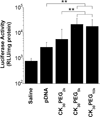Highly compacted DNA nanoparticles with low MW PEG coatings: in vitro, ex vivo and in vivo evaluation
- PMID: 21903145
- PMCID: PMC3245330
- DOI: 10.1016/j.jconrel.2011.08.031
Highly compacted DNA nanoparticles with low MW PEG coatings: in vitro, ex vivo and in vivo evaluation
Abstract
Highly compacted DNA nanoparticles, composed of single molecules of plasmid DNA compacted with block copolymers of poly-l-lysine and 10kDa polyethylene glycol (CK(30)PEG(10k)), mediate effective gene delivery to the brain, eyes and lungs in vivo. Nevertheless, we found that CK(30)PEG(10k) DNA nanoparticles are immobilized by mucoadhesive interactions in sputum that lines the lung airways of patients with cystic fibrosis (CF), which would presumably preclude the efficient delivery of cargo DNA to the underlying epithelium. We previously found that nanoparticles can rapidly penetrate human mucus secretions if they are densely coated with low MW PEG (2-5kDa), whereas nanoparticles with 10kDa PEG coatings were immobilized. We thus sought to reduce mucoadhesion of DNA nanoparticles by producing CK(30)PEG DNA nanoparticles with low MW PEG coatings. We examined the morphology, colloidal stability, nuclease resistance, diffusion in human sputum and in vivo gene transfer of CK(30)PEG DNA nanoparticles prepared using various PEG MWs. CK(30)PEG(10k) and CK(30)PEG(5k) formulations did not aggregate in saline, provided partial protection against DNase I digestion and exhibited the highest gene transfer to lung airways following inhalation in BALB/c mice. However, all DNA nanoparticle formulations were immobilized in freshly expectorated human CF sputum, likely due to inadequate PEG surface coverage.
Copyright © 2011 Elsevier B.V. All rights reserved.
Figures






References
-
- Pringle IA, Hyde SC, Gill DR. Non-viral vectors in cystic fibrosis gene therapy: recent developments and future prospects. Expert opinion on Biological Therapy. 2009;9:991–1003. - PubMed
-
- Welsh MJ, Smith AE. Molecular mechanisms of CFTR chloride channel dysfunction in cystic fibrosis. Cell. 1993;73:1251–1254. - PubMed
-
- Donaldson SH, Bennett WD, Zeman KL, Knowles MR, Tarran R, Boucher RC. Mucus Clearance and Lung Function in Cystic Fibrosis with Hypertonic Saline. New Engl. J. Med. 2006;354:241–250. - PubMed
-
- Matsui H, Verghese MW, Kesimer M, Schwab UE, Randell SH, Sheehan JK, Grubb BR, Boucher RC. Reduced three-dimensional motility in dehydrated airway mucus prevents neutrophil capture and killing bacteria on airway epithelial surfaces. J. Immunol. 2005;175:1090–1099. - PubMed
Publication types
MeSH terms
Substances
Grants and funding
LinkOut - more resources
Full Text Sources
Other Literature Sources
Research Materials

